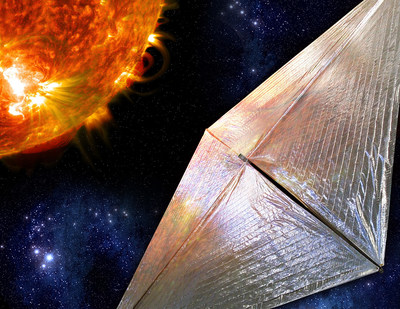Ball Aerospace Selected to Integrate and Test "Sailcraft" for NASA Solar Propulsion Technology Demonstration
Ball Aerospace has been chosen to support NASA's Solar Cruiser, a technology demonstration exploring solar propulsion in space. The project involves integrating and testing the satellite bus with a solar sail system. Scheduled for launch in 2025, the Solar Cruiser will deploy an 18,000-square-foot sail to harness solar radiation for propulsion. Ball will also contribute to additional missions under NASA's Interstellar Mapping and Acceleration Probe. This initiative reinforces Ball Aerospace's commitment to advancing aerospace technology and supporting NASA's scientific endeavors.
- Ball Aerospace selected for NASA Solar Cruiser, enhancing its reputation as a key partner in space technology.
- The project signifies advancements in solar propulsion, potentially leading to innovative future missions.
- None.
Insights
Analyzing...
BOULDER, Colo., Feb. 10, 2021 /PRNewswire/ -- Ball Aerospace has been selected to support Solar Cruiser, a NASA small satellite technology demonstration on the use of solar photons for propulsion in space. Ball will perform several mission-critical functions, including the integration and test of the satellite bus with the solar sail system that will form the completed "Sailcraft."
"Solar Cruiser will be an important step in the advancement of solar propulsion technology that could enable future missions studying the Sun, space weather and deep space," said Dr. Makenzie Lystrup, vice president and general manager, Civil Space, Ball Aerospace. "It builds on our legacy as a long-time mission partner to NASA and the scientific community, at large, in the development of leading-edge science and technology to achieve science at any scale."
The Solar Cruiser will be one of four missions launching with the NASA Interstellar Mapping and Acceleration Probe (IMAP), currently scheduled in 2025. Once in orbit, the spacecraft will deploy an 18,000-square-foot sail – roughly the size of four regulation basketball courts stitched together – to catch solar radiation to propel the vehicle. Les Johnson, from NASA's Marshall Space Flight Center in Huntsville, Alabama, is the mission's principal investigator.
Ball Aerospace will be responsible for procuring a Venus-class microsat commercial bus, defining all necessary mission-specific modifications, and performing the integration and test of the completed Sailcraft.
In addition to Solar Cruiser, Ball Aerospace will play roles on two of the other three missions launching on NASA's IMAP, including the Global Lyman-alpha Imagers of the Dynamic Exosphere (GLIDE) and the National Oceanic and Atmospheric Administration's (NOAA) Space Weather Follow On (SWFO).
Powered by endlessly curious people with an unwavering mission focus, Ball Aerospace pioneers discoveries that enable our customers to perform beyond expectation and protect what matters most. We create innovative space solutions, enable more accurate weather forecasts, drive insightful observations of our planet, deliver actionable data and intelligence, and ensure those who defend our freedom go forward bravely and return home safely. Go Beyond with Ball.® For more information, visit www.ball.com/aerospace or connect with us on Facebook or Twitter.
About Ball Corporation
Ball Corporation (NYSE: BLL) supplies innovative, sustainable aluminum packaging solutions for beverage, personal care and household products customers, as well as aerospace and other technologies and services primarily for the U.S. government. Ball Corporation and its subsidiaries employ 21,500 people worldwide and reported 2020 net sales of
Forward-Looking Statements
This release contains "forward-looking" statements concerning future events and financial performance. Words such as "expects," "anticipates," "estimates," "believes," "targets," "likely," "positions" and similar expressions typically identify forward-looking statements, which are generally any statements other than statements of historical fact. Such statements are based on current expectations or views of the future and are subject to risks and uncertainties, which could cause actual results or events to differ materially from those expressed or implied. You should therefore not place undue reliance upon any forward-looking statements and any such statements should be read in conjunction with, and, qualified in their entirety by, the cautionary statements referenced below. The Company undertakes no obligation to publicly update or revise any forward-looking statements, whether as a result of new information, future events or otherwise. Key factors, risks and uncertainties that could cause actual outcomes and results to be different are summarized in filings with the Securities and Exchange Commission, including Exhibit 99 in our Form 10-K, which are available on our website and at www.sec.gov. Additional factors that might affect: a) our packaging segments include product capacity, supply, and demand constraints and fluctuations, including due to virus and disease outbreaks and responses thereto; availability/cost of raw materials, equipment, and logistics; competitive packaging, pricing and substitution; changes in climate and weather; footprint adjustments and other manufacturing changes, including the startup of new facilities and lines; failure to achieve synergies, productivity improvements or cost reductions; unfavorable mandatory deposit or packaging laws; customer and supplier consolidation; power and supply chain interruptions; potential delays and tariffs related to the U.K's departure from the EU; changes in major customer or supplier contracts or a loss of a major customer or supplier; political instability and sanctions; currency controls; changes in foreign exchange or tax rates; and tariffs, trade actions, or other governmental actions, including business restrictions and shelter-in-place orders in any country or jurisdiction affecting goods produced by us or in our supply chain, including imported raw materials; b) our aerospace segment include funding, authorization, availability and returns of government and commercial contracts; and delays, extensions and technical uncertainties affecting segment contracts; c) the Company as a whole include those listed above plus: the extent to which sustainability-related opportunities arise and can be capitalized upon; changes in senior management, succession, and the ability to attract and retain skilled labor; regulatory action or issues including tax, environmental, health and workplace safety, including U.S. FDA and other actions or public concerns affecting products filled in our containers, or chemicals or substances used in raw materials or in the manufacturing process; technological developments and innovations; the ability to manage cyber threats; litigation; strikes; disease; pandemic; labor cost changes; rates of return on assets of the Company's defined benefit retirement plans; pension changes; uncertainties surrounding geopolitical events and governmental policies both in the U.S. and in other countries, including policies, orders and actions related to COVID-19, the U.S. government elections, stimulus package(s), budget, sequestration and debt limit; reduced cash flow; interest rates affecting our debt; and successful or unsuccessful joint ventures, acquisitions and divestitures, and their effects on our operating results and business generally.
![]() View original content to download multimedia:http://www.prnewswire.com/news-releases/ball-aerospace-selected-to-integrate-and-test-sailcraft-for-nasa-solar-propulsion-technology-demonstration-301225956.html
View original content to download multimedia:http://www.prnewswire.com/news-releases/ball-aerospace-selected-to-integrate-and-test-sailcraft-for-nasa-solar-propulsion-technology-demonstration-301225956.html
SOURCE Ball Aerospace








